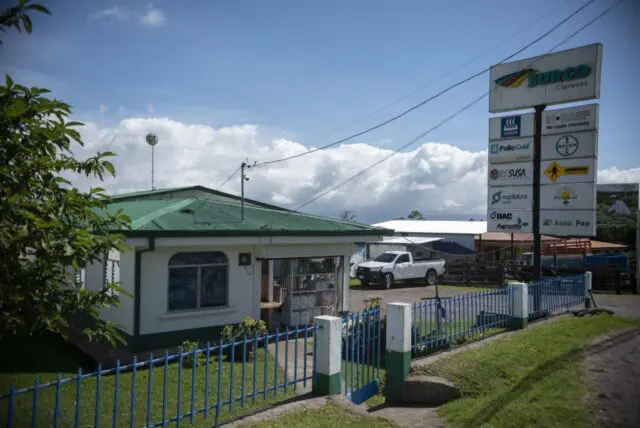Costa Rica: the world’s largest consumer of pesticides per hectare
Chlorothalonil is the fourth best-selling fungicide in Costa Rica, according to data compiled by Elidier Vargas. Vargas investigates the use of agrochemicals and is the author of studies sponsored by the local office of the United Nations Development Program (UNDP). These studies show that this Central American nation, known internationally as the “greenest country in the world,” is also one of the world’s largest consumers of pesticides per hectare. In the agricultural region near the Irazú volcano, it is “daily bread,” says Ismael Serrano, a farmer who owns a factory in Cipreses that processes carrots for export, located right next to where the first tanker truck was parked in October. past to bring water to the locals.

Serrano was president of Cipreses ASADA, the authority that manages the town’s water system, until nearly nine years ago, and he blames its current directors for allowing the water supply to become contaminated. He says that because ASADA did not buy the lands surrounding the springs, farmers farm a few meters from these water sources, even though the law says there must be a distance of at least 200 meters. Serrano says that he always knew that the concerns raised by EcoCipreses were not just the whims of activists. “They were right. There is now evidence that chlorothalonil particles are present in the water. Other countries have studied the serious effects they have on health,” he told Unearthed and Public Eye, in an interview at his factory.
“One lives in fear”
The risk to human health causes fear in a part of the town due to the potential effects derived from a substance that has been applied for decades without control or measurements. “One lives in fear and often wonders when something strange will come out in the body,” he admits. Óscar Ruiz, although he and his son Jordi still fumigate their carrot field with chlorothalonil with a motor pump and without protective equipment.
“A week ago I lost a 45-year-old employee to stomach cancer,” says Ismael Serrano at his packing plant. “He died, and now his dad has it too. I wonder if it’s related.” Up the road in Santa Rosa, Unearthed and Public Eye meet 70-year-old Leonel Sánchez as he goes to get water from the truck. His wife has cancer and his son has kidney failure, so they don’t want to “run the risk of drinking contaminated water,” says this retired farmer, who used to use chlorothalonil and always drank the tap water without a second thought. But now heed the warnings. “We always use large amounts of agrochemicals on our farms and no one warned us about them,” he says.
Doctors in Costa Rica who spoke to Unearthed and Public Eye said the country’s monitoring of cancer rates in general and pesticide-related harm in particular was weak, and it was impossible to say whether the pesticides used around Cipreses were directly related to the diseases observed.
Effects to health
It is true that the effects of exposure to chlorothalonil on health have not been measured, warns Dr. Rebeca Alvarado, an epidemiologist investigating the effects of pesticides for UNDP. In Costa Rica, the effects of agrochemicals are only recorded when it comes to immediate crises, but not the damage accumulated over time in the form of chronic diseases. “What we have is international literature that talks about relationships of the substance with problems of asthma, cancer, damage to the renal system, the prostate and the female reproductive system, without ruling out others,” said Alvarado. What we know here is that there are substances derived from chlorothalonil that are in the water and we cannot establish a causality with diseases in this place, but there is something clear: people are consuming residues of a substance whose adverse effects on health have been proven in other countries”.
The local board responsible for the Cipreses water service does not accept that the water it provides represents a risk to the health of residents. In stark contrast to its counterparts in neighboring Santa Rosa, Asada de Cipreses doesn’t even accept that its water is contaminated. When the Ministry of Health issued the order in October to the president of Cipreses ASADA, VirgilioUlloa, to close the use of the springs for human consumption, he told the press that the water system would continue to function normally, that “here no one has died from this” and that people consume “more poison in their vegetables than they think”.
In a two-hour interview with Unearthed and Public Eye, Ulloa dismissed the credentials of IRET, the university institute whose tests discovered the contamination, despite the fact that his ASADA contracted with IRET to perform some of those tests. It now alleges that the institute’s laboratory is not officially accredited to analyze chlorothalonil metabolites and claims that IRET was under pressure from local activists to produce the results it did. “This board made the mistake of hiring our enemies to do the tests,” says Ulloa, a local farmer who tooth and nail defends the use of pesticides in the area. During the interview, he wears a cap with the logo of the store where we bought the Bravonil.
Ulloa’s doubts are not shared by Dárner Mora, the director of Costa Rica’s National Water Laboratory, which belongs to the government institution responsible for water services and for supervising rural aqueducts, such as the one in Cipreses. This state lab is certified to test for chlorothalonil metabolites, but doesn’t have the resources to do the work itself, so it now works with IRET. “You always have to apply science, and if the IRET laboratory detects metabolites, we believe it,” says Mora. He has no doubt that the waters of the springs in the entire upper area of the province of Cartago have a high risk of contamination, due to the terrain and the type of agriculture in the region.
A second opinion
Rather than accept the advice of these scientists, the Cipreses ASADA, with the close support of representatives of the Costa Rican pesticide industry, has sought a “second opinion”. Earlier this year, ASADA commissioned a new round of tests from a new laboratory, the Environmental Pollution Research Center (CICA) of the University of Costa Rica (UCR). The only apparent purpose of these tests was to convince the town that there was no problem in drinking the tap water or continuing to spray the crops, because CICA had made it clear from the beginning that it could test for chlorothalonil, but that it does not have the capacity to analyze the metabolites.
However, the ASADA still commissioned new tests and the samples were taken on February 2 in the spring called “Plantón”, located at the bottom of a pot-shaped piece of land in whose surroundings there are abundant fields of papaya and cabbage, without respect the 200 meters of protection required by law. There were the members of the local board, its administrator Sonia Aguilar, a lawyer and businessman Freddy Solís, presented as president of the Association of Formulators and Marketers of Agrochemicals (Asoagro), according to the transmission made by a local journalist who was paid on Facebook. for it. Solís is also the manager of the company called DistribuidoraInquisa, which also markets chlorothalonil. “He is an entrepreneur who gives a lot of support in the ASADA with the issue of agrochemicals”, Sonia Aguilar, administrator of the board, said that day.
Speaking to Unearthed and Public Eye, Solís said that he has participated as part of the industry and that he is convinced that the October health order is based “on presumptions.” It also rules out damages from chlorothalonil to health or the environment if it is used properly and in the doses that are read in the small letters on the packaging. “The use of agrochemicals adhering to the manufacturer’s recommendations on the label and pamphlet, has shown that it does not cause adverse risks to health or the environment and is a tool to ensure the food safety of the population, in full compliance with the national legislation,” said the businessman.
CropLife Latin America, the trade body that represents Syngenta and other pesticide multinationals in the region, issued a statement suggesting that the problem was that the Costa Rican Ministry of Health had set too strict a limit on the amount of pesticides that may be in drinking water.
“What is relevant is not detecting whether or not pesticide residues appear in food products or water, but rather the level at which they are appearing, given that, as long as the VMA (maximum acceptable values) are not exceeded, there is no risk to the consumer; as long as the VMAs have been established following internationally accepted scientific norms and standards, which is not the case in Costa Rica,” the statement read.
They added that the Costa Rican regulations, which establish a maximum acceptable limit for any pesticide in drinking water of 0.1 micrograms per liter, have been established “without any technical or scientific foundation.”
This limit is exactly the same as that established by the European Union for the amount of pesticide that can be present in drinking water or groundwater. Also, in the EU, this same limit applies to chlorothalonil metabolites, due to the pesticide’s classification as a chemical that can cause cancer.
Assurances from the pesticide industry have not been reassuring for the Costa Rican National Institute of Aqueducts, the Ministry of Health, the Ministry of the Environment or the Constitutional Chamber of its Supreme Court, all of whom acknowledge a contamination problem.


